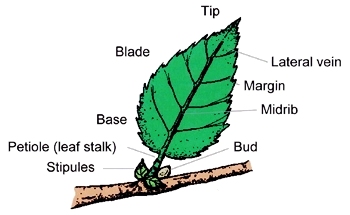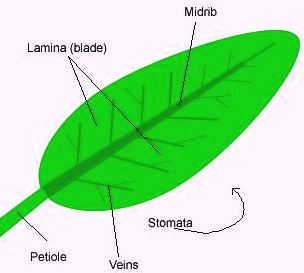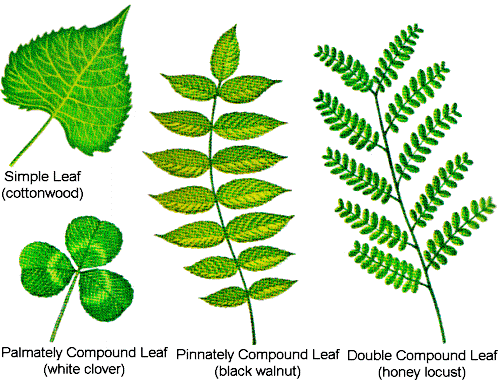Leaf
Table of Content |

 - The leaf is a green, flat, thin, expanded lateral appendage of stem which is borne at a node and bears a bud in its axil.
- The leaf is a green, flat, thin, expanded lateral appendage of stem which is borne at a node and bears a bud in its axil.
- It is exogenous in origin and develops from the leaf primordium of shoot apex.
- The green colour of leaf is due to presence of the photosynthetic pigment – chlorophyll which helps plants to synthesize organic food.
- The green photosynthetic leaves of a plant are collectively called foliage.
- They are borne on stem in acropetal succession.
Characteristics of Leaf
(i) The leaf is a lateral dissimilar appendage of the stem.
(ii) A leaf is always borne at the node of stem.
(iii) Generally there is always an axillary bud in the axil of a leaf.
(iv) It is exogenous in origin and develops from the swollen leaf primordium of the growing apex.
(v) The growth of leaf is limited.
(vi) The leaves do not possess any apical bud or a regular growing point.
(vii) A leaf has three main parts – Leaf base, petiole and leaf lamina. In addition, it may possess two lateral outgrowths of the leaf base, called stipules.
(viii) The leaf lamina is traversed by prominent vascular strands, called veins.
Parts of a Typical Leaf
The leaf consists of three parts namely, leaf base (usually provided with a pair of stipules), petiole and leaf blade or lamina.
(i) Leaf base (Hypopodium) : Leaf base is the lower most part of the leaf meant for attachment. It acts as a leaf cushion. In most of the plants it is indistinct. Sometimes leaf base shows different variations as follows :
(a) Pulvinate leaf base : In members of leguminosae the leaf is swollen. Such swollen leaf bases are called pulvinate leaf bases as seen in mango leaves. It helps in seismonastic movements (e.g., Mimosa pudica) and nyctinastic movements (e.g., Enterobium, Arachis, Bean).
(b) Sheathing leaf base : In grasses and many monocots, the leaf base is broad and surrounds the stem as an envelope, such a leafbase is called sheathing leaf base. e.g., Sorghum, Wheat and Palms. In grasses (Sorghum, Wheat etc.) the sheathing leaf base protects the intercalary meristem.
(c) Modified leaf base : The leaf bases in few plants perform accessory functions and show modifications. In Allium cepa (Onion), the leaf bases store food materials and become fleshy. They are arranged concentrically to form a tunicated bulb. In Platanus and Robenia, the leaf bases protect the axillary buds and grow around them to form cup like structures.
(d) Stipule : The stipules are the small lateral appendages present on either side of the leaf base. They protect the young leaf or leaf primordia. Leaves with stipules are called stipulate and those without them are called exstipulate. The stipules are commonly found in dicotyledons. In some grasses (Monocots) an additional outgrowth is present between leaf base and lamina. It is called ligule. The leaves having ligules are called ligulate. Sometimes, small stipule like outgrowths are found at the base of leaflets of a compound leaf. They are called Stipules.
Types of Stipules
Depending upon the structure and position various kinds of stipules are recognized.
-
Free lateral stipules : A pair of freely arranged stipules present on either side of the leaf base are called free lateral stipules, e.g., Hibiscus and Cotton.
-
Adnate stipules : The two stipules that fuse with the leaf base or petiole on either side are called adnate stipules, e.g., Arachis and Rose.
-
Inter petiolar stipules : Stipules present in between the petioles of opposite leaves, e.g., Ixora and Hamelia.
-
Axillary stipules : Stipules present in the axil of a leaf are called axillary stipule. These are also called intrapetiolar stipule, e.g., Tabernamontana and Gardenia.
-
Ochraceous stipules : Membranous tubular stipules that ensheath the axillary bud and a part of internode is called ochraceous stipule. It is formed by the union of two stipules, e.g., Polygonum and Rumex.
-
Hairy stipules : These are hair like stipules which are dry in nature, e.g., Anacampsora.
-
Modification of stipule : To carryout different functions, stipules of some plants undergo modifications. They are classified as follows :
-
Foliaceous : Green, expanded, leaf like stipules are called foliaceous stipules. They carryout photosynthesis, hence called assimilatory stipules, e.g., Pisum sativum and Lathyrus.
-
Spinous : In some plants the stipules are modified into hard, pointed defensive organs called spines, e.g., Acacia arabica, Prosopis juliflora and Zizyphus.
-
Convolute or Bud scales : Scales which protect the buds are called bud scales. Sometimes they are the modified to stipules. The bud scales fall off as the buds open, e.g., Artocarpus and Ficus.
(ii) Petiole (Mesopodium) : A petiole or leaf stalk is a cylindrical or sub cylindrical structure of a leaf which joins the lamina to the base. It raises the lamina above the level of stem so as to provide it with sufficient light exposure. A leaf with a petiole is called petiolate and the one without it is called sessile.
(a) Modification of petiole
-
Winged petiole : Green, flattened petioles may be called winged petioles, e.g., Citrus and Dionaea.
-
Tendrillar petiole : In few plants the petioles are modified into tendrils and helps the plant in climbing. e.g., Clematis and Tropaeolum.

-
Leaf like petiole (Phyllode) : A modified petiole which is flat, green and lamina like is called phyllode. It is a photosynthetic organ. e.g., Acacia auriculae formis.
-
Swollen or Spongy petiole : Sometimes the petiole becomes swollen and spongy due to the development of aerenchyma. The type of petioles encloses much air and helps the plant to float. It is a hydrophytic adaptation e.g., Trapa bispinosa and Eichhornia.
-
Spinous petiole : In few plants, the leaf blades fall off and the petioles become hard and spinous e.g., Quisqualis (Rangoon creeper).
(iii) Lamina (Epipodium) : The green expanded portion of the leaf is called the lamina. It performs vital functions like photosynthesis and transpiration. The nature of lamina depends upon the species and age of the leaf. A leaf lamina shows variations in different aspects like shape, margin, apex, texture and venation.
(d) Surface of lamina : The surface of the lamina may be of many kinds.
-
Glabrous : Smooth and without hair. e.g,. Mangifera indica.
-
Glaucus : Covered by waxy coating with white tinge. e.g., Calotropis.
-
Scabrous : Rough surface. e.g., Ficus.
-
Viscose : Sticky surface. e.g., Cleome.
-
Pubescent : Covered with soft and wooly hair. e.g., Tomato.
-
Pilose : Covered with long distinct scattered hair. e.g., Grewia pilosa.
-
Hispid : Covered with long rigid hair. e.g., Cucurbita.
-
Spinose : Covered with small spines. e.g., Solanum xanthocarpum.
e) Texture of lamina : The texture of lamina also varies in different species.
-
Herbaceous : When the lamina is thin and soft.
-
Coriaceous : When the lamina is leathery.
-
Succulent : When the lamina is thick, soft and juicy.
-
Hygrophytic : When the lamina is very thin, membranous and spongy.
(3) Types of leaves : On the basis of shape of lamina, the leaves are classified into two types, namely, simple leaf and compound leaf.
(i) Simple leaves : The leaf having single undivided lamina is called the simple leaf. The simple leaf may be entire (e.g., Mango and Hibiscus rosa sinensis) or lobed. The lobes of a simple leaf may be entire pinnately arranged (e.g., Brassica) or palmately arranged (e.g., Gossypium, Passiflora and Ricinus).
(ii) Compound leaves : A compound leaf is one in which the lamina or the leaf blade is completely divided into many segments or units called leaflets or pinnae. When pinnae of leaflets attached in various ways to the portion of leaf axis known as the rachis. The compound leaves may be of two types, namely, pinnate compound leaves and palmately compound leaves.
(a) Pinnate compound leaves : It is the most familiar and widesperead type of compound leaf in which the rachis is elongated and bears two rows of simple or divided leaflets. The leaflets may be arranged alternately or in pairs along with the rachis. It is of following types :
-
Unipinnate compound leaf : Here the primary rachis is unbranched and bear leaflets on either side. Unipinnate leaves are of two types :
-
Paripinnate : The unipinnate leaf with even number of leaflets. They are borne in pairs. e.g., Tamarindus indica (Imli), Cassia etc.
-
Imparipinnate : The unipinnate leaf with odd number of leaflets. The rachis is terminated by single unpaired leaflet. e.g., Neem, Rose, Murraya.
-
Bipinnate compound leaf : In this type, the primary rachis is divided once and produce secondary and tertiary rachis. The leaflets develop on the secondary rachis. e.g., Delonix and Acacia, Mimosa pudica, Albizzia.
-
Tripinnate compound leaf : In this type the primary rachis divides twice and produces secondary and tertiary rachii. The leaflets develops on the tertiary rachii. e.g., Moringa (Soanjana) and Millingonia.
-
Decompound leaf : Here the primary rachis divides many times without any definite order. The lamina is dissected into many units. e.g., Coriandrum.
(b) Palmate compound leaf : In a palmately compound leaf, the leaflets are arranged at the tip of the petiole. According to the number of leaflets present at the tip of the petiole. These leaves are following types :
-
Unifoliate : In this case, a palmately compound leaf is reduced to a single terminal leaflet. The single leaflet is articulated to the top of petiole, e.g., Citrus (Khatta), Lemon, etc.
-
Bifoliate : This type of leaf has only two leaflets attached side by side at the terminal end of petiole, e.g., Balanites roxburghii, Hardwickia binata, etc.
-
Trifoliate : This type of leaf has three terminal leaflets, Aegle marmelos (Wood apple, vern. Bael), Oxalis corniculata, Trifollium (Clover), etc. These leaves differ from trifoliate imparipinnate (e.g., Lablab) in having all the three leaflets attached at the tip of petiole.
-
Quadrifoliate : This leaf has four leaflets attached to the tip of petiole. e.g., Paris quadrifolia, Marsilea.
-
Multifoliate : A palmately compound leaf having five or more terminal leaflets, arranged as fingers of the palm, e.g., Bombax malabarica, Cleome viscosa, Gynandropsis pentaphylla, etc.
(4) Phyllotaxy (Phyllotaxis) : The leaves may be stem borne (cauline), branch borne (ramal) or may appear to be root borne (radical). The arrangement of leaves on the stem is called phyllotaxy (Gk. Phyllon = leaf; taxis = arrangement). It is of three types :
(i) Alternate or Spiral : When only one leaf is found at each node. The leaves present at successive nodes alternate with each other. The arrangement is said to be alternate or spiral. The leaves are commonly arranged spirally around the stem. Each spiral is called the genetic spiral.
(ii) Opposite : When two leaves are present at node opposite to each other the type of phyllotaxy is called opposite. It is of two type :
(a) Opposite superposed : All the pair of leaves of a branch arise in the same plane so that only two vertical rows of leaves are formed. e.g., Jamun, Guava, etc.
(b) Opposite decussate : A pair of leaves at one node stands at right angle to the next upper or lower pair so that four vertical rows are formed on the stem. e.g., Calotropis, Zinnia, Tulsi, Quisqualis.
(iii) Whorled : If more than two leaves are present at a node as whorl, it is called whorled phyllotaxy. It is also called cyclic or verticellate phyllotaxy. e.g., Nerium, Hydrilla and Alstoni scholaris.
(iv) Leaf mosaic : This is a special type of arrangement of leaves. Older leaves present at the lower nodes of the stem possess longer petioles with bigger lamina and the young leaves of upper nodes bear shorter petioles with smaller lamina. The smaller young leaves occupy the space present between the bigger ones. e.g., Begonia, Acalypha and Sycamore.
(5) Vernation : Arrangement of leaves in bud condition is known as vernation imbricate (irregular overlapping), contorted (twisted, regular overlapping of margins), induplicate (margin bent inwardly), equitant (conduplicate in two series, one overlapping the other completely), half equitant, supervolute (convolute leaves, one rolled over other).
(6) Heterophylly : It is the occurrence of more than one type of leaves on the same plant. Heterophylly is of four types :
(i) Adaptive heterophylly : Submerged leaves are different from floating and emerged leaves of the same plant due to different adaptations. e.g., Limnophila heterophylla, Sagittaria, Ranunculus aquatilis. The emerged leaves are broad and fully expanded while the submerged leaves are narrow, ribbon shaped, linear or highly dissected.
(ii) Environmental heterophylly : The heterophylly is due to change in environment including soil, temperature, humidity and air currents.
(iii) Developmental heterophylly : Young leaves are different from mature leaves, e.g., Eucalyptus.
(iv) Habitual heterophylly : Leaves of different shape and incisions occur at the same time, e.g., Jack fruit tree (Artocarpus heterophyllus), Ficus heterophylla, Hemiphragma heterophyllum, Broussonetia papyrifera. In Hemiphragma, the main stem bears ovate and entire leaves while branches possess acicular leaves.
(7) Modification of leaves : Some important leaf modification are as follows :
(i) Leaf tendrils : In many weak stemmed plants, the leaves are modified into slender wiry and coiled structures called leaf tendrils. The tendril may be formed by entire leaf or a part of the leaf.
-
Entire leaf modified into tendril, e.g., Lathyrus aphaca (Wild pea).
-
Terminal leaflets modified into tendril, e.g., Pisum sativum (Pea), Lathyrus odoratus (Sweet pea), Narvella.
-
Leaf tip modified into tendril, e.g., Gloriosa.
-
Petiole modified in to tendril, e.g., Clematis.
-
Stipule modified into tendril, e.g., Smilax.
-
Midrib modified into tendril, e.g., Nepenthes.
(ii) Spines : A pointed structure formed by the modification of entire leaf or part of a leaf is called a spine. Different part of a leaf or entire leaf may be modified in to spines. e.g., In Opuntia leaves of axillary branches are modified into spines. In Berberis entire leaf modified into three spines. In Phoenix leaf tip modified into spine. In Citrus first leaf of axillary branch modified in to spine. In Argimone leaf margin modified into spines. In Perkinsonia, Acacia and Zizyphus stipules modified into spines.
(iii) Scale leaves : In many xerophytes, the foliage leaves are reduced to scale leaves. They are thin, membranous, dry, small, sessile, colourless structure. e.g., Casuarina, Orobanche and Balanophora.
(iv) Phyllode : It is a green, expanded structure formed by the modification of petiole or rachis of leaf. Many xerophytes reduce the size of their leaves to minimize water loss. Such plant develop phyllodes to carry out photosynthesis e.g., Acacia, Melanoxylon and Parkinsonia.
(v) Storage leaves : Leaves become fleshy due to storage of water or food materials. Such leaves are called storage leaves. They are usually found in succulent plants. In plants like Aloe, Kalanchoe and Peperomia.
(vi) Reproductive leaves : In some plants the vegetative propagation is carried out by the production of epiphyllous buds on leaves. Such leaves are called reproductive leaves. The epiphyllous buds when come in contact with soil develop into new plants.
(vii) Absorbing leaves : In some rootless, aquatic plants, the submerged leaves are modified into root like structure to absorb water and mineral salts. Such modified leaves are called absorbing leaves. e.g., Utricularia.
(viii) Floral leaves : Floral parts such as sepals, petals, stamens and carpels are modified leaves. Sepals and petals are leafly stamens are considered pollen bearing microsporophylls and carpels are ovule bearing megasporophylls.
(ix) Cotyledons : The mature embryo shows either one (monocotyledons) or two cotyledons, (dicotyledons). Cuscuta a parasite is included in dicotyledon. However it has no cotyledon and many cotyledons, as in gymnosperms. These cotyledons are considered as embryonic leaves which are the first leaves of a shoot system.
(x) Trap leaves : The trap leaves are also called insectivorous leaves or carnivorous leaves. Plants having trap leaves usually grow in nitrogen-deficient soils (boggy soils). They have poorly developed root system. These plants get their nitrogenous requirement by capturing the insects. To attract, capture, kill and digest the insects, the leaves are modified into trap leaves.
Question 1 : A leaf is identified from
(a) Flat green lamina
(b) Presence of leaf blade and petiole
(c) Presence of axillary bud
(d) Occurrence of chlorophyll
Ans: c
Question 2 : Leaves fall off from branches in winter due to
(a) Formation of abscission layer
(b) Shortening of day length
(c) Fall in temperature
(d) All the above
Ans: a
Question 3 : Finely dissected leaves occur in
(a) Free floating plants
(b) Rooted floating leaved plants
(c) Submerged plants
(d) Emerged plants
Ans: c
Question 4 : In Tamarind (Imli) the pinnate leaf is
(a) Tripinnate
(b) Bipinnate
(c) Paripinnate
(d) Imparipinnate
Ans: c
Question 5 : Presence of sheathing leaf base and ligule are characteristic of
(a) Cycas leaf
(c) Banana leaf
(d) Grass leaf
Ans: d
Related Resources
-
Click here to refer the Useful Books of Biology for NEET (AIPMT)
-
Click here for study material on Anatomy of Flowering Plants
To read more, Buy study materials of Morphology of Flowering Plants comprising study notes, revision notes, video lectures, previous year solved questions etc. Also browse for more study materials on Biology here.
View courses by askIITians


Design classes One-on-One in your own way with Top IITians/Medical Professionals
Click Here Know More

Complete Self Study Package designed by Industry Leading Experts
Click Here Know More

Live 1-1 coding classes to unleash the Creator in your Child
Click Here Know More





